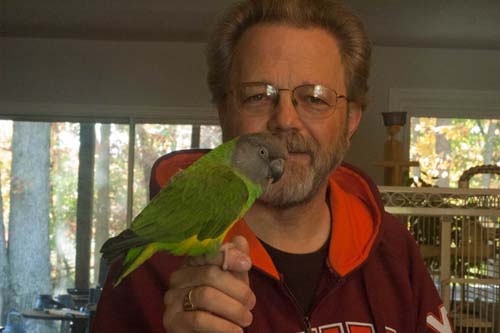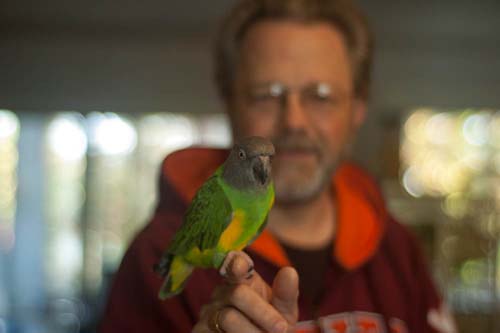This blog is about me taking better pictures. This week I’m working on emphasizing what is important in the photos. There are lots of ways to to do this, but I’m going to work on using depth of field. My challenge is to take two photographs of the same subject using the aperture settings on my camera to highlight different points of interest. My husband and parrot have kindly consented to help me out.
In this first picture both my husband and BirdieBert are in focus because I have a relatively large depth of field. It was shot with a 50 mm lens at a 1/5 second shutterspeed and aperture of f/22.

In the second photo only BirdieBert is in focus which is the way she thinks it should be. It was shot with the same 50 mm lens at 1/60 second and an aperture of f/1.8.

Using my aperture setting to control depth of field will help me take better pictures by directing viewers attention to the subject of the photo. Larger apertures (like f/2 and f/2.8) can help me get shallower depths of field. The distance between me and my subject also affects my depth of field. The focal length of the lens matters, too.
If I need to review the 3 factors that control depth of field I can look at that topic in Cambridge in Color.
The technique for using blurry backgrounds is called bokeh and if I want to look at beautiful photos using this technique, I can go to this article, Luminous Landscape.
For my next blog, I challenge myself to capture motion three different ways.


I think you did a great job of showing the difference in depth of field. Oddly enough, to me anyways, this is such a difficult photographic tool for people to understand. Another term you may find in the same context of depth of field is bokeh which refers to the way the out of focus portion looks, i.e. the way the light is in circles where the window used to be clear.
In my opinion when you learn about how to use a camera and how to control light you have 3 main items to focus on. The sensor or film sensitivity (ISO), the aperture setting (f-stop) and the shutter speed. Each of these allows you to control the light in a picture.
As a side note on this topic of depth of field you may want to look at how focal length impacts depth of field. If you were to shoot a picture of your husband framed the same way on a 50mm lens at f/5.6 and then step back far enough to frame him the same at 300mm at f/5.6 you will see that the background of the 300mm photo will have a much shallower looking depth of field.
Paul,
Your suggestions for including distance to subject as another factor for depth of field and the term, bokeh, were good. I’ve incorporated both and revised the post. ISO would be a good topic for another post. Thank you for helping me with my site.